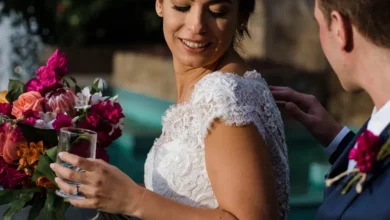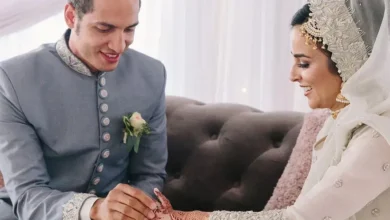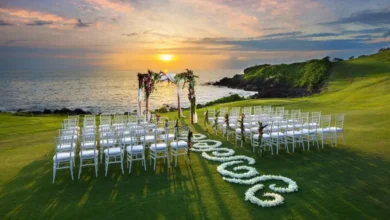Chinese Wedding Attire: Grace Woven in Red and Gold
The Chinese wedding dress is more than just attire; it’s a symbol of heritage, history, and hope for a prosperous future. Rich in symbolism and tradition, these gowns tell a story woven with threads of culture and family. Whether you’re planning a wedding or simply curious about the customs, this guide will offer a deep dive into the captivating world of Chinese wedding attire.
The Evolution of Chinese Wedding Dresses
Understanding the evolution of the Chinese wedding dress provides crucial context to its current forms. Historically, styles varied dramatically based on dynastic changes and regional influences. Early designs often focused on deep reds, considered auspicious, and incorporated elaborate embroideries depicting mythical creatures like dragons and phoenixes, symbolizing masculine and feminine energy respectively. Let’s explore some key historical periods:
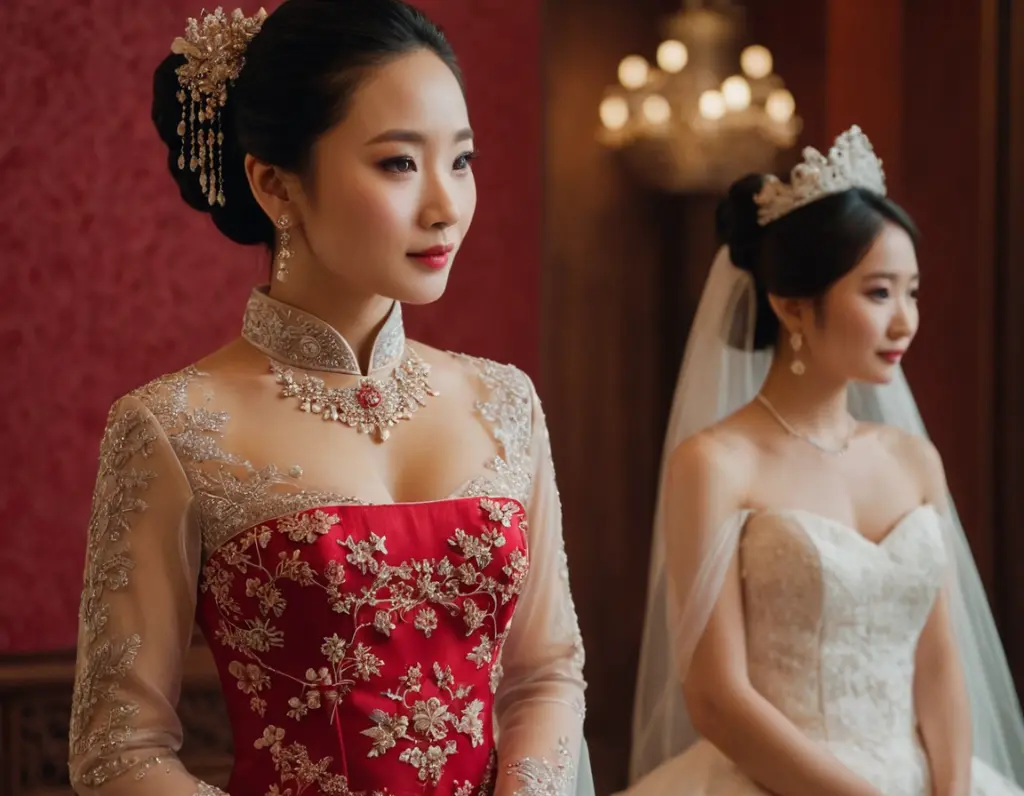
Early Dynasties (Pre-Qing)
Prior to the Qing Dynasty, wedding attire was more varied. Brides wore garments that reflected their social status and the prevailing fashion of the time. Colors other than red, though less common, were sometimes incorporated. Heavy brocade fabrics were favored, and the designs often included flowing silhouettes and wide sleeves. The emphasis was on rich materials and intricate craftsmanship rather than a singular style.
The Qing Dynasty and the Qipao
The Qing Dynasty (1644-1912) brought the rise of the qipao (also known as the cheongsam) as a prominent garment, and its influence dramatically shaped the Chinese wedding dress. Initially a loose-fitting, long gown worn by Manchu women, the qipao evolved to become more tailored and figure-hugging.
See also The Elegance of Moroccan Wedding Dresses
The Elegance of Moroccan Wedding Dresses
For weddings, these garments were rendered in rich silks and satins, featuring elaborate embroidery, often with gold and silver threads. The color red became increasingly standardized as the dominant hue for bridal attire during this period.
Modern Adaptations
Today, the Chinese wedding dress is a blend of tradition and modernity. While the qipao remains a popular choice, designers are constantly innovating, offering a wide array of styles, silhouettes, and embellishments. Brides often choose to honor tradition with a classic red qipao for the tea ceremony or reception, while opting for a Western-style white gown for the ceremony itself. This fusion reflects a growing globalized world and the desire to personalize wedding celebrations while respecting cultural heritage.
Key Elements of Traditional Chinese Wedding Dresses
Traditional Chinese wedding dresses are imbued with symbolism, each element carefully chosen for its auspicious meaning. Let’s explore some of the common features:
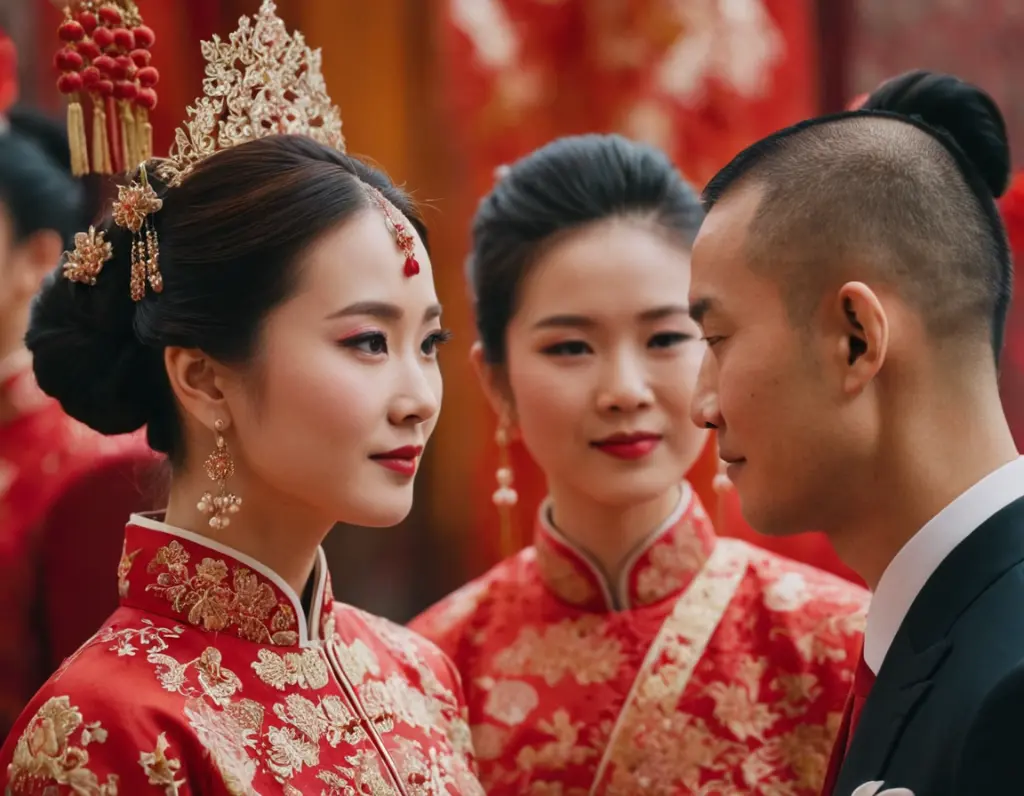
The Auspicious Color Red
The most iconic feature of a traditional Chinese wedding dress is the color red. In Chinese culture, red symbolizes good fortune, happiness, prosperity, and love. It’s believed to ward off evil spirits and bring luck to the marriage. The deeper the red, the more auspicious it is considered. While other colors are sometimes incorporated as accents, red remains the primary and most powerful color.
See also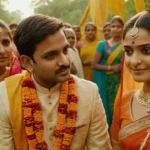 The Timeless Elegance of Indian Wedding Dresses
The Timeless Elegance of Indian Wedding Dresses
Symbolic Embellishments
Embroidery plays a crucial role in the beauty of a Chinese wedding dress. These embroidered motifs are far from decorative; they are carefully chosen for their symbolic meanings. Common motifs include:
- Dragons and Phoenixes: These mythical creatures represent the perfect balance of yin (feminine, phoenix) and yang (masculine, dragon) energy, symbolizing marital harmony and prosperity.
- Peonies: These flowers represent wealth, honor, and love. They are often depicted in full bloom, signifying a bright and prosperous future for the couple.
- Butterflies: These delicate creatures symbolize happiness, joy, and longevity. Their vibrant colors add an element of beauty to the garment.
- Mandarin Ducks: These birds are known for their lifelong pairing, signifying fidelity, loyalty, and a long-lasting marriage.
- Double Happiness Symbol (囍): This symbol is explicitly used to represent the joy of marriage and is often incorporated directly onto the dress.
Fabrics and Silhouettes
Traditionally, Chinese wedding dresses are made from luxurious materials such as silk, satin, and brocade. These fabrics are chosen not only for their beauty but also for their durability and ability to drape well. The silhouette of the dress can vary greatly, from the figure-hugging qipao to looser, more flowing styles. The choice depends on personal preference and the overall wedding theme. The weight of the fabric and its texture add to the overall feel of the garment, contributing to the significance of the bride’s look.
Different Styles of Chinese Wedding Dresses
While the red qipao is a classic, there are many different styles of Chinese wedding dresses to choose from. Understanding these variations can help brides find the perfect gown that aligns with their personal style and the specific traditions they wish to honor:
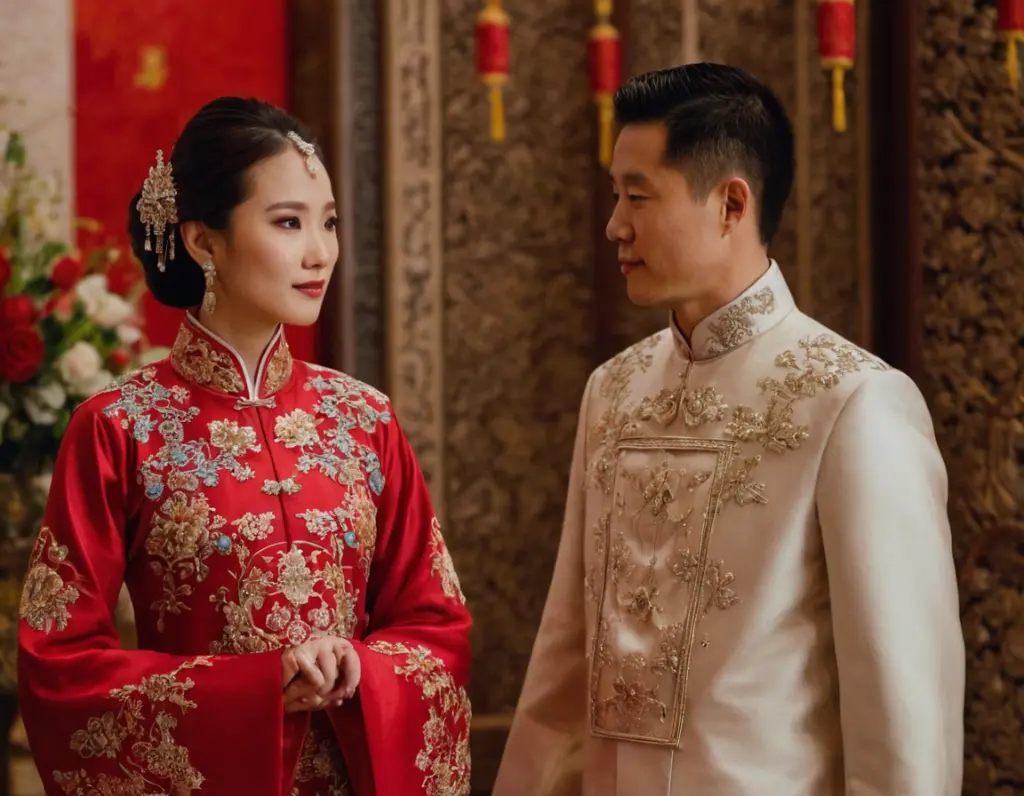
The Qipao (Cheongsam)
The qipao is perhaps the most well-known style of Chinese wedding dress. It is a close-fitting, one-piece dress with a high collar and a side slit. Traditionally made in red and embroidered with auspicious symbols, it often features a mandarin collar, frog closures, and a tailored silhouette. Its elegance and timeless appeal make it a favorite for many brides.
The Kwa (Quà)
The kwa, or quà, is a two-piece dress traditionally worn in Southern China, particularly in Cantonese culture. It usually consists of a jacket and a long skirt, both heavily embroidered with gold and silver threads. Common motifs include dragons and phoenixes, and the garment often carries significant weight due to the extensive embroidery. The kwa is known for its opulent and majestic appearance.
The Hanfu
The hanfu is a traditional Chinese garment that predates the qipao. It encompasses a variety of styles from different historical periods, with flowing robes and wide sleeves. While not as common as the qipao for modern weddings, the hanfu is experiencing a resurgence in popularity among younger generations who wish to embrace older traditions. Bridal hanfu are usually made in rich colors with delicate and intricate detailing, and often incorporates multiple layers for a luxurious, elegant effect.
Modern Interpretations
Today’s designers often blend traditional elements with modern styles, creating unique Chinese wedding dresses that appeal to contemporary brides. These might include modified qipao with different necklines or sleeve lengths, gowns incorporating traditional embroidery on Western-style silhouettes, or even playful combinations of different cultural elements. This allows brides to celebrate their heritage while expressing their individual style.
The Significance of the Tea Ceremony Attire
A significant part of the Chinese wedding tradition is the tea ceremony, where the bride and groom serve tea to their respective families, symbolizing respect and gratitude. The attire worn for the tea ceremony often differs from the main ceremony dress. Here’s why and how:
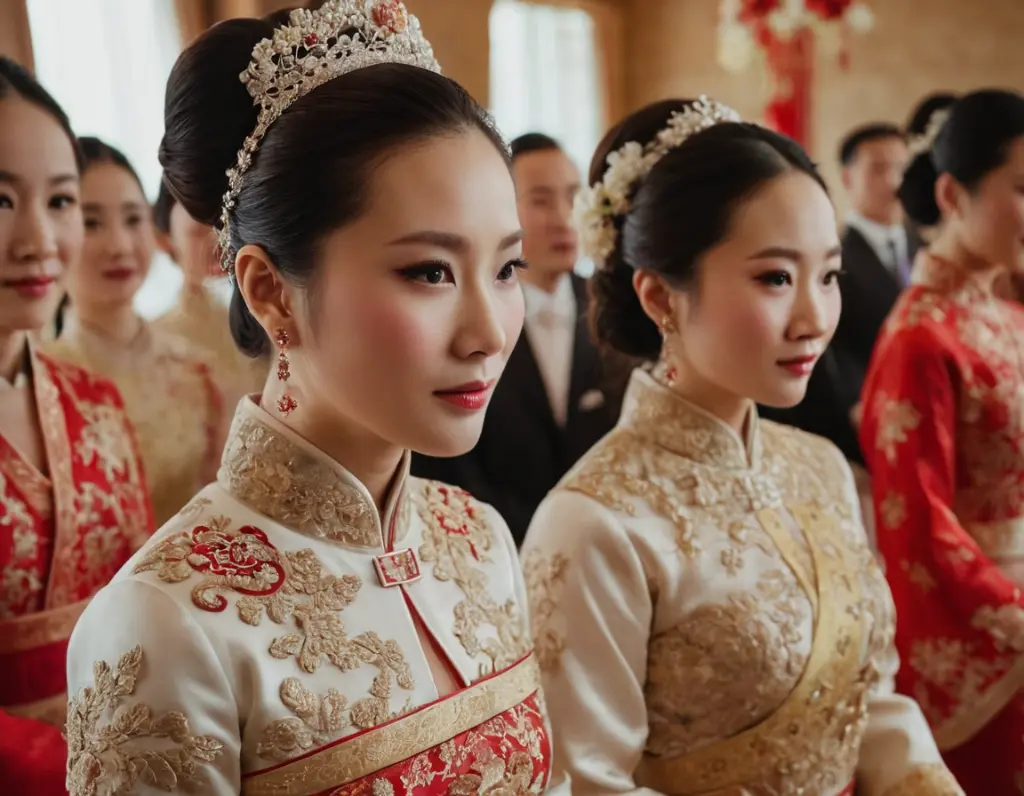
Respect and Tradition
The tea ceremony is a moment of deep respect, and the attire reflects this. Typically, brides choose a Chinese wedding dress, such as a *qipao* or *kwa*, in a more traditional red color for this occasion. The dress is often paired with traditional hair accessories and jewelry, enhancing the overall look of reverence and honoring familial customs. The attire for this ceremony is less about fashion and more about honoring cultural roots and familial relationships.
Comfort and Practicality
While the tea ceremony attire should be beautiful, it also needs to be practical. The bride will be moving around a lot, serving tea to multiple family members. Therefore, many choose a qipao or *kwa* with slightly less voluminous or restricting design.
Comfortable shoes or flats are often preferred over high heels. The ability to move gracefully while performing this key part of the wedding tradition is a crucial consideration. This blend of beauty and practicality ensures the bride is both radiant and at ease during this significant event.
Color and Symbolism
Red remains the predominant color choice for tea ceremony attire due to its auspicious connotations. Gold embroidery is frequently incorporated to signify wealth and prosperity, reinforcing the well-wishes for the newly married couple.
Although red is dominant, some variations in shades may occur depending on personal preferences or regional customs. The overall emphasis is on conveying good fortune and paying respect to elders through both attire and actions during the ceremony.
Choosing Your Perfect Chinese Wedding Dress
Selecting the right Chinese wedding dress is a deeply personal journey. Here are some key factors to consider:
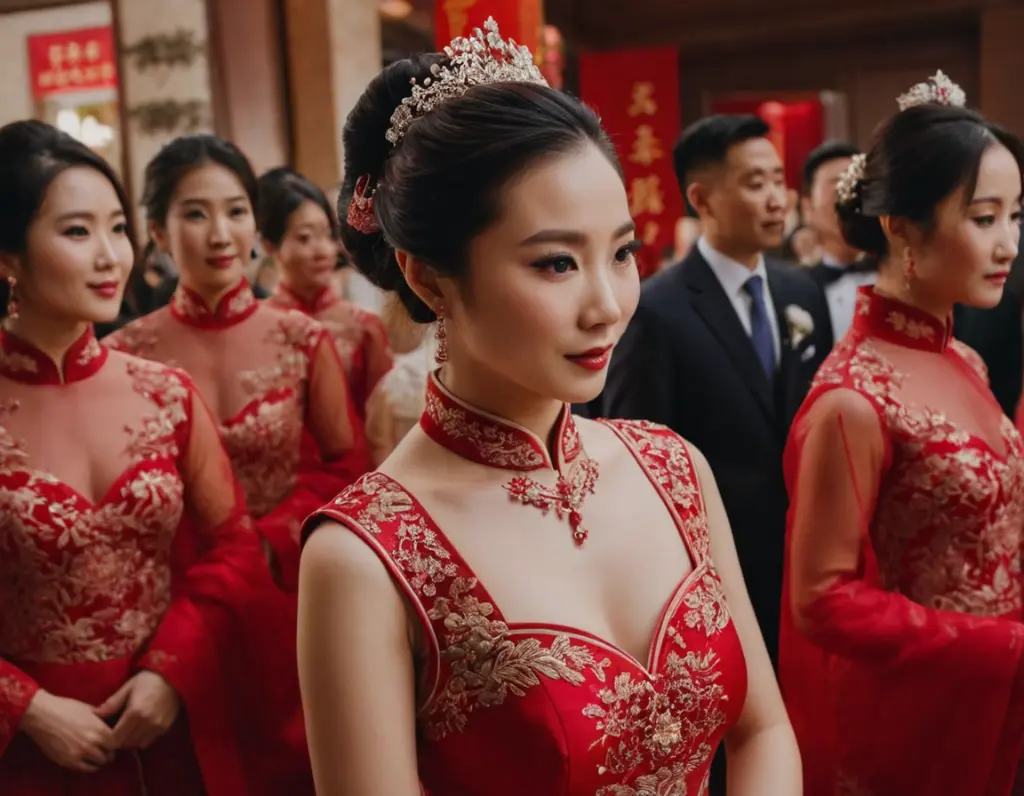
Your Personal Style
Your wedding dress should reflect your personal style and preferences. Do you prefer a classic, elegant look or something more modern and bold? Consider your overall wedding theme and the specific cultural traditions you want to highlight. Choosing a dress that aligns with your individual taste will ensure you feel beautiful and comfortable on your special day.
Body Type and Fit
Different styles of Chinese wedding dresses suit different body types. The figure-hugging qipao might be ideal for those wanting to accentuate their figure, while looser styles like the *hanfu* may be more comfortable for others. It is crucial to try on different styles and work with a skilled seamstress or designer to find the perfect fit that enhances your features and allows for comfortable movement on your wedding day.
Budget
Chinese wedding dresses can range in price from affordable ready-to-wear options to high-end custom designs. Establish your budget beforehand and explore various options. Consider whether you’re more comfortable renting, buying a pre-made gown, or having a dress custom-made. Weigh the pros and cons of each option and ensure it fits within your financial plan.
Cultural Considerations
If you want to honor specific cultural traditions, speak with your family or consult with someone familiar with the customs of your region. It’s important to understand the symbolism and significance of different styles and motifs to make informed choices that reflect your heritage and values. Open communication ensures your wedding dress honors cultural roots while representing your personal journey as well.
Caring for Your Chinese Wedding Dress
Proper care is essential to maintain the beauty and longevity of your Chinese wedding dress. Here are some tips:
Professional Cleaning
Because of the delicate fabrics and embroidery involved in Chinese wedding dresses, it’s advisable to have them professionally cleaned. A reputable dry cleaner specializing in delicate materials will be best equipped to clean and preserve your gown effectively, safeguarding the intricate details from damage or fading. Avoid attempting home cleaning methods that could potentially harm the dress.
Proper Storage
Store your dress in a garment bag made from breathable materials, such as cotton or muslin. This protects it from dust, pests, and direct sunlight. Avoid storing your dress in plastic, as this can trap moisture and potentially damage the fabric. Ensure the storage location is cool and dry, as temperature and humidity variations can cause harm to delicate embroidery and materials.
Handling with Care
When handling your dress, make sure to wash your hands first or wear clean gloves. Avoid wearing perfumes or lotions, as they can leave stains or damage delicate fibers. When not in use, keep it folded carefully and try to handle it as little as possible. Taking these simple precautions will contribute to the longevity and overall preservation of your gown.
Regular Inspection
Even when stored properly, it’s beneficial to inspect your dress periodically for any signs of damage. Look for loose threads, stains, or fading colors. Addressing minor issues early on can prevent further damage and keep your gown in pristine condition for years to come. Regular, gentle checks are an important aspect of maintenance.
The Chinese wedding dress is a captivating blend of art, tradition, and personal expression. From its rich history to its symbolic details, every aspect of this garment holds significant cultural importance. Whether you choose a classic red qipao, an opulent *kwa*, or a modern fusion design, your wedding dress will be a powerful reflection of your heritage and a beautiful symbol of the love and commitment you share with your partner. By understanding its nuances, you’ll be able to select a gown that not only looks stunning but also deeply resonates with your personal story and cultural background.
